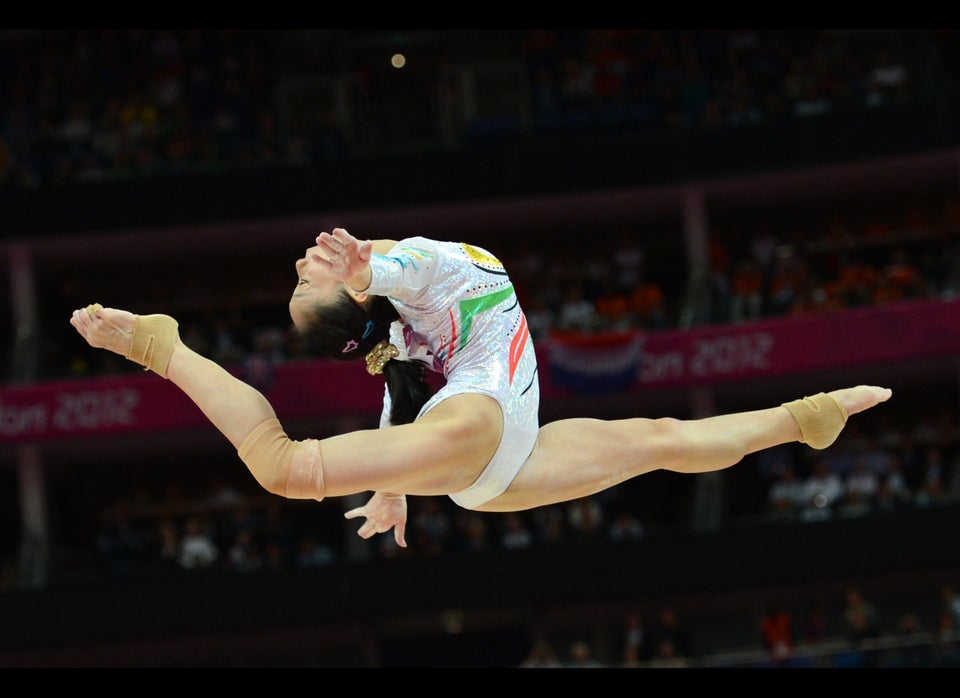
As the world marvels at the athletic prowess on display at the Olympic Games, many people are also talking about the breathtaking photography coming out of London. The summer Olympics may come and go every four years, but the images will last a lifetime. We'll remember Gabby Douglas' historic gymnastics performance and also her infectious smile for decades to come. (Check out a "Games On!" lightbox.)
Whether you're shooting an Olympic event or just a neighborhood ballgame, the right techniques can help you capture exciting sports images. Below, we've collected some advice from blog posts around the web by veteran Olympic photographers who have covered sports' biggest events. Here are some of their tricks of the trade:
1. Get the background shot.
The enthusiastic and colorful crowd in the stands paints a powerful backdrop. When covering other sporting events, you might take measures to dull out the crowd, said Jeff Cable at Photography Blog. That's not the case here. "The Olympics is one of those rare times in sports photography when I want to include the background. The great colors, huge crowd, and Olympic rings on the walls add to the visual impact." Discover what is happening both on and off the court.
2. Get close.
At other times, though, you'll want to focus directly in on the athletes themselves. Their bodies and bends are what draws us in, and photography can highlight both. "You don't need to show the whole scene or an entire athlete's body to make a great sports photo," said Chris Wilkins at The Dallas Morning News. "By shooting incredibly tight, you can often increase the storytelling value of a sports photograph." Figuring out whether to go wide or tight for each picture is key.
3. Get educated.
If you think you have a hard time keeping up with the rules and strategy of various games, imagine having to cover them. Figuring out what to focus on can be rather taxing if you don't already have some familiarity with the sport. Any and all information you can uncover about the athletes' tendencies will help you prepare for the right moments. In swimming, for instance, knowing stroke patterns will give you an edge. Any photographer can catch athletes' emotions immediately following a victory or a defeat; to capture someone in the heat of battle, however, you need to know what to look for.
4. Get comfortable.
It's not just the Olympics' opening ceremony that lasts a while, said Robert Gauthier in the Los Angeles Times. While athletes are competing, photographers are also vying for the best position. To achieve that at such a large-scale event like the Olympics, it requires everyone to arrive early to get situated. From there, Gauthier and others wait. And wait. Once the games begin, it's all worth it. "Focused on elite athletes in search of glory, the soreness in my shoulders and butt melts away, as does the smell."
5. Get inventive.
Olympic followers were amazed last week by how far photographers will go to get the perfect shot. A New York Times article revealed that among those covering the London games are skilled scuba divers who operate equipment -- a camera inside of a clear glass dome that costs $30,000 -- at the bottom the pool. They check regularly on the battery, positioning, and connections. Photographers have covered the Olympics in this way since 1992, but not every news outlet is credentialed to cover swimming events underwater. But even those who have approval and control the underwater equipment say that they have to tinker with it from time to time to avoid getting the same types of pictures repeatedly.
6. Get creative.
Some photographers have come up with interesting ways to help their pictures stand out. See what is possible through the use of cameras with multiple exposures. It's an ideal time to try some experimental photography to showcase the action in a different way. Imaginative techniques have resulted in many magnificent images. Every photographer should first consider all of the methods and possibilities available.
This post originally ran on the Shutterbuzz blog.
See some amazing Olympics photos below:
